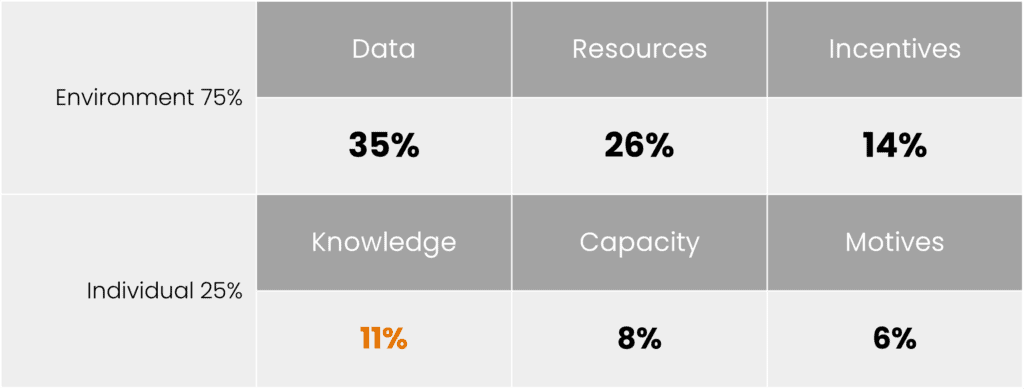
It’s day six. We’re glad you’re still with us. It’s important to finish this series, as one block builds upon the other until you have what it takes to build a successful performance culture.
As we discussed yesterday, coaching is a powerful way to ensure the performance of your employees moves from average to excellent. Oftentimes though, even with the best coaching, your people will face challenges, and inside or outside influences will impact their performance.
Is Training the Right Solution?
Normally, when an organization identifies a performance problem, the first solution leadership jumps to is training. If training isn’t the right solution to the problem—and nearly nine times out of ten it isn’t—training won’t help solve the problem. And training is expensive! This means a lot of money spent to still have the same problem.

Training should only be used if there is an identified knowledge or skill gap that training can solve. This could be determined by:
- Analyzing a problem with performance and determining that a knowledge/skill gap needs to be filled.
- Identifying gaps in knowledge, skills, and abilities during coaching sessions with one or more performers.
- Ascertaining the performer’s need to practice performance in a safe environment where failures have no real-world consequences.
Training is only valuable if it results in improved job performance. When training is only used for the right reasons and in the right way, you can:
- Solve those lingering problems for which traditional training has never worked.
- Create training that actually works.
- Reduce costs by spending less on training and shifting spending to solutions that work.
- Build shorter, less expensive training that is also more effective.
- Improve performance and increase productivity.
- Increase employee engagement in training by keeping training relevant to their performance.

Uncover the Root Cause
Training should never be the first assumed solution. There are many possible causes for a problem, and the only way to find the right one is to analyze the situation to find the root cause. A diagnostic performance analysis involves:
- Determining an organization’s business results to ensure that processes align with its goals.
- Creating a process map or evaluating an existing process map for the processes being affected by the performance problem.
- Creating performance profiles for affected roles and performance profiles on process outputs.
- Identifying problem outputs. Interviews with managers and exemplary performers help to determine existing performance support and other factors that influence performance both positively and negatively. These influences include expectations and feedback, tools and resources, incentives and consequences, skills and knowledge, capacity, and motivation.
- Synthesizing the analysis findings and making recommendations for additional performance support to help increase positive influential factors and remove negative ones.
Training will only be a listed solution in the analysis findings if there are identified skill and knowledge deficits uncovered from those interviews. Traditional training is not the only way to fill a skill and knowledge gap. Training is only necessary if performers need to practice a skill in a safe environment or have immediate access to information during the course of work—meaning they need to memorize it for later recall.
If, however, there is no urgent recall required, it is much more economical and effective to create job aids that the performer can use. Job aids are a better tool overall in most circumstances because they do not rely on the performers’ ability to retain information in their brains. If a performer misremembers some aspect of the job and they have a job aid to correct them, the job still gets done right.
Ensure Training Is More Valuable Than Its Cost
If training is determined to be necessary, it is important to ensure the training is more valuable than its cost by:
- Limiting trainees to those who have a skill or knowledge deficit that is required for them to do their jobs correctly.
- Verifying retention of the skills and knowledge covered and improved job performance as a result.
- Ensuring the performer can perform the job to standards at the end of training.
- Providing job aids when possible to supplement the training.
When used in the right way, training can become an effective and useful tool to improve performance, but it should never be used as the remedy for every problem that ails an organization. When problems are approached with analysis to diagnose the real problem and propose effective solutions, organizations can avoid costly training that doesn’t work and limit training to effective methods that provide value to the performers and the organization.
A Shift in Focus
Building a performance culture involves a shift in focus, and it’s not going to happen overnight. One major shift is this one: moving away from “training” as the default solution to fixing every problem, especially when we know that it is NOT the best solution almost 90% of the time!
With just one more day left, don’t let today’s topic just slip through too quickly. Really consider this concept and apply it everywhere in your organization. A training mindset focuses on knowledge and behaviors. A performance mindset focuses on results, or outcomes.
Tomorrow, we jump into measuring performance against those defined outcomes. See you then!


